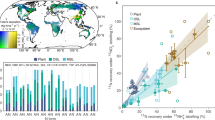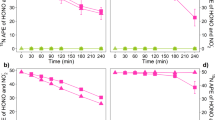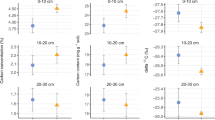Abstract
Nitrogen cycling is an important aspect of forest ecosystem functioning. Pristine temperate rainforests have been shown to produce large amounts of bioavailable nitrogen, but despite high nitrogen turnover rates, loss of bioavailable nitrogen is minimal in these ecosystems. This tight nitrogen coupling is achieved through fierce competition for bioavailable nitrogen by abiotic processes, soil microbes and plant roots, all of which transfer bioavailable nitrogen to stable nitrogen sinks, such as soil organic matter and above-ground forest vegetation. Here, we use a combination of in situ 15N isotope dilution and 15N tracer techniques in volcanic soils of a temperate evergreen rainforest in southern Chile to further unravel retention mechanisms for bioavailable nitrogen. We find three processes that contribute significantly to nitrogen bioavailability in rainforest soils: heterotrophic nitrate production, nitrate turnover into ammonium and into a pool of dissolved organic nitrogen that is not prone to leaching loss, and finally, the decoupling of dissolved inorganic nitrogen turnover and leaching losses of dissolved organic nitrogen. Identification of these biogeochemical processes helps explain the retention of bioavailable nitrogen in pristine temperate rainforests.
This is a preview of subscription content, access via your institution
Access options
Subscribe to this journal
Receive 12 print issues and online access
$259.00 per year
only $21.58 per issue
Buy this article
- Purchase on Springer Link
- Instant access to full article PDF
Prices may be subject to local taxes which are calculated during checkout

Similar content being viewed by others
References
Vitousek, P. M. & Reiners, W. A. Ecosystem succession and nutrient retention: A hypothesis. Bioscience 25, 376–381 (1975).
Hedin, L. O., Armesto, J. J. & Johnson, A. H. Patterns of nutrient loss from unpolluted, old-growth temperate forests: Evaluation of biogeochemical theory. Ecology 76, 493–509 (1995).
Perakis, S. S. & Hedin, L. O. Fluxes and fates of nitrogen in soil of an unpolluted old-growth temperate forest, southern Chile. Ecology 82, 2245–2260 (2001).
Perakis, S. S. & Hedin, L. O. Nitrogen loss from unpolluted South American forests mainly via dissolved organic compounds. Nature 415, 416–419 (2002).
Perakis, S. S., Compton, J. E. & Hedin, L. O. Nitrogen retention across a gradient of 15N additions to an unpolluted temperate forest soil in Chile. Ecology 86, 95–105 (2005).
Huygens, D. et al. Soil nitrogen conservation mechanisms in a pristine south Chilean Nothofagus forest ecosystem. Soil Biol. Biochem. 39, 2448–2458 (2007).
Schimel, J. P. & Bennett, J. Nitrogen mineralization: Challenges of a changing paradigm. Ecology 85, 591–602 (2004).
Wood, P. M. Autotrophic and heterotrophic mechanisms for ammonia oxidation. Soil Use Manag. 6, 78–79 (1990).
De Boer, W. & Kowalchuk, G. A. Nitrification in acid soils: Micro-organisms and mechanisms. Soil Biol. Biochem. 33, 853–866 (2001).
Booth, M. S., Stark, J. M. & Rastetter, E. Controls on nitrogen cycling in terrestrial ecosystems: A synthetic analysis of literature data. Ecol. Monogr. 75, 139–157 (2005).
Killham, K. Heterotrophic nitrification. Spec. Publ. Soc. Gen. Microb. 20, 117–126 (1986).
Gallet, C. & Lebreton, P. Evolution of phenolic patterns in plants and associated litters and humus of a mountain forest ecosystem. Soil Biol. Biochem. 27, 157–165 (1995).
Aerts, R. The advantages of being evergreen. Trends Ecol. Evol. 10, 402–407 (1995).
Bending, G. D. & Read, D. J. Lignin and soluble phenolic degradation by ectomycorrhizal and ericoid mycorrhizal fungi. Mycol. Res. 101, 1348–1354 (1997).
Stark, J. M. & Hart, S. C. High rates of nitrification and nitrate turnover in undisturbed coniferous forests. Nature 385, 61–64 (1997).
Silver, W. L., Herman, D. J. & Firestone, M. K. Dissimilatory nitrate reduction to ammonium in upland tropical forest soils. Ecology 82, 2410–2416 (2001).
Davidson, E. A., Chorover, J. & Dail, D. B. A mechanism of abiotic immobilization of nitrate in forest ecosystems: The ferrous wheel hypothesis. Glob. Change Biol. 9, 228–236 (2003).
Brookshire, E. N. J., Valett, H. M., Thomas, S. A. & Webster, J. R. Atmospheric N deposition increases organic N loss from temperate forests. Ecosystems 10, 252–262 (2007).
Weathers, K. C. & Likens, G. E. Clouds in southern Chile: An important source of nitrogen to nitrogen-limited ecosystems? Environ. Sci. Technol. 31, 210–213 (1997).
Guggenberger, G. & Kaiser, K. Dissolved organic matter in soil: Challenging the paradigm of sorptive preservation. Geoderma 113, 293–310 (2003).
Qualls, R. G. & Haines, B. L. Biodegradability of dissolved organic matter in forest throughfall, soil solution, and stream water. Soil Sci. Soc. Am. J. 56, 578–586 (1992).
Vitousek, P. M. Nutrient cycling and nutrient use efficiency. Am. Nature 199, 533–572 (1982).
Pett-Ridge, J., Silver, W. L. & Firestone, M. K. Redox fluctuations frame microbial community impacts on N-cycling rates in a humid tropical forest soil. Biogeochemistry 81, 95–110 (2006).
Burton, J., Chen, C. R., Xu, Z. H. & Ghadiri, H. Gross nitrogen transformations in adjacent native and plantation forests of subtropical Australia. Soil Biol. Biochem. 39, 426–433 (2007).
Pedersen, H., Dunkin, K. A. & Firestone, M. K. The relative importance of autotrophic and heterotrophic nitrification in a conifer forest soil as measured by 15N tracer and pool dilution techniques. Biogeochemistry 44, 135–150 (1999).
Kaiser, K., Guggenberger, G., Haumaier, L. & Zech, W. Seasonal variations in the chemical composition of dissolved organic matter in organic forest floor layer leachates of old-growth Scots pine (Pinus sylvestris L.) and European beech (Fagus sylvatica L.) stands in northeastern Bavaria, Germany. Biogeochemistry 55, 103–143 (2001).
Kalbitz, K., Kaiser, K., Bargholz, J. & Dardenne, P. Lignin degradation controls the production of dissolved organic matter in decomposing foliar litter. Eur. J. Soil Sci. 57, 504–516 (2006).
Qualls, R. G. Comparison of the behavior of soluble organic and inorganic nutrients in forest soils. For. Ecol. Manag. 138, 29–50 (2000).
Strahm, B. D. & Harrison, R. B. Mineral and organic matter controls on the sorption of macronutrient anions in variable-charge soils. Soil Sci. Soc. Am. J. 71, 1926–1933 (2007).
Huygens, D., Boeckx, P., Van Cleemput, O., Oyarzun, C. E. & Godoy, R. Aggregate and soil organic carbon dynamics in south Chilean Andisols. Biogeosciences 2, 159–174 (2005).
Bengtsson, G. & Bergwall, C. Fate of 15N labelled nitrate and ammonium in a fertilized forest soil. Soil Biol. Biochem. 32, 545–557 (2000).
Silver, W. L., Thompson, A. W., Reich, A., Ewel, J. J. & Firestone, M. K. Nitrogen cycling in tropical plantation forests: Potential controls on nitrogen retention. Ecol. Appl. 15, 1604–1614 (2005).
Dail, D. B., Davidson, E. A. & Chorover, J. Rapid abiotic transformation of nitrate in an acid forest soil. Biogeochemistry 54, 131–146 (2001).
Aber, J. D. et al. Nitrogen saturation in temperate forest ecosystems: Hypothesis revisited. Bioscience 48, 921–934 (1998).
Colman, B. P., Fierer, N. & Schimel, J. P. Abiotic nitrate incorporation in soil: Is it real? Biogeochemistry 84, 161–169 (2007).
Seitzinger, S. P. & Sanders, R. W. Contribution of dissolved organic nitrogen from rivers to estuarine eutrophication. Mar. Ecol. - Prog. Ser. 159, 1–12 (1997).
Oyarzún, C. E., Godoy, R., De Schrijver, A., Staelens, J. & Lust, N. Water chemistry and nutrient budgets in an undisturbed evergreen rainforest of southern Chile. Biogeochemistry 71, 107–123 (2004).
Jardine, P. M., Weber, N. L. & McCarthy, J. F. Mechanisms of dissolved organic-carbon adsorption on soil. Soil Sci. Soc. Am. J. 53, 1378–1385 (1989).
Kaiser, K. & Zech, W. Release of natural organic matter sorbed to oxides and a subsoil. Soil Sci. Soc. Am. J. 63, 1157–1166 (1999).
Qualls, R. G., Haines, B. L. & Swank, W. T. Fluxes of dissolved organic nutrients and humic substances in a deciduous forest. Ecology 72, 254–266 (1991).
IUSS Working Group WRB. World Soil Resources Report No. 103, (2006).
Andersen, M. K. & Jensen, L. S. Low soil temperature effects on short-term gross N mineralisation-immobilisation turnover after incorporation of a green manure. Soil Biol. Biochem. 33, 511–521 (2001).
Davidson, E. A., Hart, S. C., Shanks, C. A. & Firestone, M. K. Measuring gross nitrogen mineralization, immobilization, and nitrification by 15N isotopic pool dilution in intact soil cores. J. Soil Sci. 42, 335–349 (1991).
Leenheer, J. A. Comprehensive approach to preparative isolation and fractionation of dissolved organic carbon from natural waters and wastewater. Environ. Sci. Technol. 15, 578–587 (1981).
Vandenbruwane, J., De Neve, S., Qualls, R. G., Salomez, J. & Hofman, G. Optimization of dissolved organic nitrogen (DON) measurements in aqueous samples with high inorganic nitrogen concentrations. Sci. Total Environ. 386, 103–113 (2007).
Mulvaney, R. L. in Methods of Soil Analysis (ed. Sparks, D. L.) 1123–1184 (ASA and SSSA, Madison, 1996).
Hauck, R. D. in Methods of Soil Analysis (eds Page, A. L., Miller, R. A. & Keeney, D. R.) 735–779 (ASA and SSSA, Madison, 1982).
Stevens, R. J. & Laughlin, R. J. Determining 15N in nitrite or nitrate by producing nitrous oxide. Soil Sci. Soc. Am. J. 58, 1108–1116 (1994).
Huygens, D. et al. On-line technique to determine the isotopic composition of total dissolved nitrogen. Anal. Chem. 79, 8644–8649 (2007).
Barraclough, D. & Puri, G. The use of 15N pool dilution and enrichment to separate the heterotrophic and autotrophic pathways of nitrification. Soil Biol. Biochem. 27, 17–22 (1995).
Acknowledgements
This research was supported by the Fund for Scientific Research - Flanders (Belgium) (FWO, G.0426.04) and a Bilateral Scientific and Technological Cooperation between Flanders and Chile (BOF, UGent). R.G. would like to thank the National Commission for Scientific and Technological Research - Chile (FONDECYT). Support during field campaigns was provided by Y. Rivas, G. Guevara, P. Etcheverría, Y. Ugarte, E. Padilla, L. Almonacid and J. Peters. We are grateful to the CONAF, especially to N. Pacheco, for supporting our research. We acknowledge E. Gillis, K. Van Nieuland and J. Vermeulen for isotope analyses.
Author information
Authors and Affiliations
Contributions
All authors worked out the study aims, discussed the results and edited/commented on the manuscript; D.H., P.B., L.P., C.O. and R.G. participated in field sampling campaigns; D.H., P.B. and P.T. prepared experimental set-up and scientific protocols. D.H. wrote the manuscript, analysed water samples and carried out data analysis; D.H., P.B. and R.G. supervised the project; P.T. provided expertise on 15N field work and techniques during a scientific exchange programme of D.H.
Corresponding author
Supplementary information
Supplementary Information
Supplementary table S1 (PDF 96 kb)
Rights and permissions
About this article
Cite this article
Huygens, D., Boeckx, P., Templer, P. et al. Mechanisms for retention of bioavailable nitrogen in volcanic rainforest soils. Nature Geosci 1, 543–548 (2008). https://doi.org/10.1038/ngeo252
Received:
Accepted:
Published:
Issue Date:
DOI: https://doi.org/10.1038/ngeo252
This article is cited by
-
Integrative knowledge-based nitrogen management practices can provide positive effects on ecosystem nitrogen retention
Nature Food (2023)
-
Heterotrophic nitrification of organic nitrogen in soils: process, regulation, and ecological significance
Biology and Fertility of Soils (2023)
-
Land Use on Volcanic Ash Soils and its Influence on Greenhouse Gases Emissions Under Laboratory Conditions
Journal of Soil Science and Plant Nutrition (2023)
-
Microbial Respiration and Nitrogen and Phosphorus Mineralization in Cow Dung–Amended Soils Depending on Moisture Contents: a Microcosm Study
Journal of Soil Science and Plant Nutrition (2022)
-
Laboratory investigation on calcium nitrate induced coupling reactions between nitrogen, phosphorus, sulfur, and metals in contaminated sediments
Environmental Science and Pollution Research (2021)



